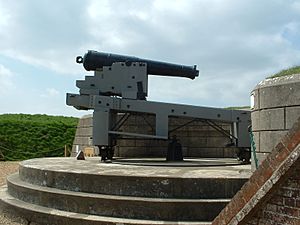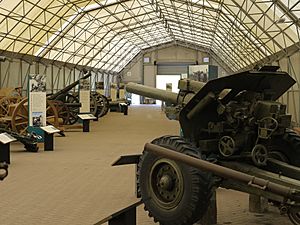Fort Nelson, Hampshire facts for kids
Quick facts for kids Fort Nelson, Hampshire |
|
|---|---|

64pdr R.M.L. on traversing carriage – part of the original armament of Fort Nelson.
|
|
| Type | Palmerston fort |
| Location | Boarhunt |
| OS grid reference | SU 60696 07203 |
| Area | Hampshire |
| Built | 1860–1867 |
| Owner | Hampshire County Council |
|
Listed Building – Grade I
|
|
| Official name: Fort Nelson, Boarhunt | |
| Designated | 22 Dec 1971 |
| Reference no. | 1350616 |
| Lua error in Module:Location_map at line 420: attempt to index field 'wikibase' (a nil value). | |
Fort Nelson, in the civil parish of Boarhunt in the English county of Hampshire, is one of five defensive forts built on the summit of Portsdown Hill in the 1860s, overlooking the important naval base of Portsmouth. It is now part of the Royal Armouries, housing their collection of artillery, and a Grade I Listed Building.
Description
Fort Nelson is a typical Polygonal or Palmerston Fort. It is six-sided with a deep ditch protected by three caponiers. Above each caponier is a well-protected emplacement for 13-inch mortars. It was originally entered by two Guthrie rolling bridges and has a barrack block for 172 officers and men, protected by a V-shaped redan. A large open parade ground gives access to the magazines 40 feet underneath it. There are open emplacements on the ramparts for 64 pounder rifled muzzle-loading guns and 6.6 inch howitzers. There are also three Haxo casemates for 7 inch rifled breech-loaders.
History
Fort Nelson is one of five Portsdown Forts. Built as a result of the 1859 Royal Commission by Lord Palmerston to prevent a French land attack, on the Portsmouth dockyard only 8 kilometres away, because the older Hilsea Lines at the bottom of the ridge were considered insufficient. A series of 6 forts were built along the 7 miles (10 km) of the ridge. From west to east they are forts Fareham, Wallington, Nelson, Southwick, Widley and Purbrook. The line was finished off at the eastern end with Crookhorn Redoubt and Farlington Redoubt. A garrison of around 200 volunteers accompanied by regular army officers would have manned the fort in time of war. Construction was protracted and Fort Nelson wasn't fully armed until the 1890s. The fort was disarmed in 1907 and then used for accommodation. In 1938, it was converted to an area anti-aircraft ammunition store; ten large magazines were built on the parade ground. Fort Nelson was abandoned in the 1950s.
Royal Armouries
Following a fire caused by vandalism in 1988 it was reclaimed by the MOD and sold to Hampshire County Council for £50,000. Hampshire County Council restored it at a cost of £3-4million, and it opened to the public in 1994, becoming part of the Royal Armouries in 1995. It houses their collection of artillery, including:
- The 'Boxted Bombard', an English wrought iron cannon from around 1450, which was powerful enough to fire a 60 kg granite ball
- The 'Dardanelles Gun', a Turkish bronze cannon from 1464 which was powerful enough to fire stone balls with a diameter of 63 cm
- French field guns captured at the Battle of Waterloo
- Fortress guns from India and China.
- Parts of the famous Iraqi 'Project Babylon' Gulf War-era supergun.
- One of the two Mallet's Mortars.
- Several SBBL 32 pounders
The fort covers around 19 acres (77,000 m2) and is open all year round, with no charges except for some special events. Live firing demonstrations are held every day, costumed guides, video presentations, and visitors are able to explore the tunnels that run below the fort connecting the magazines with gun emplacements. There are displays demonstrating the living and working conditions of the soldiers who manned the fort, and views over Portsmouth, the Solent, Hayling Island and Gosport, with the Isle of Wight beyond.
- Portsdown Hill article.




